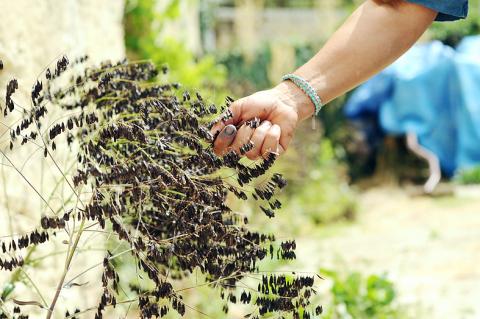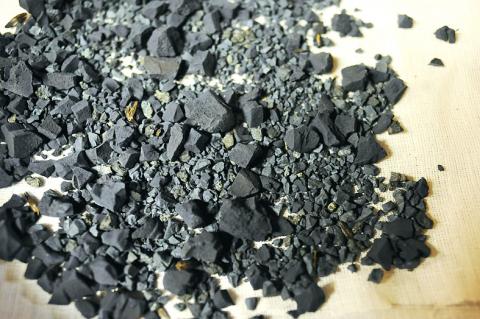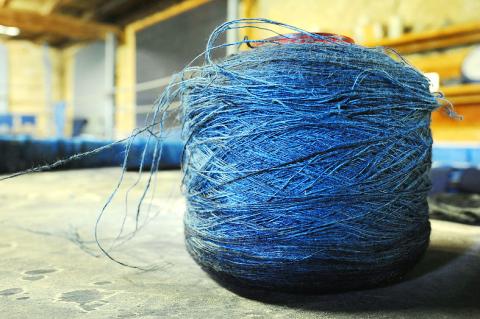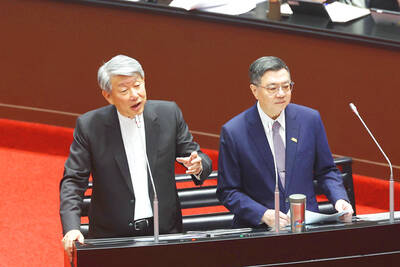It took an American in southwest France to revive an ancient blue dye that once brought riches to the region and was so prized it was lauded in Geoffrey Chaucer’s poetry and used for uniforms in Napoleon’s army.
“We brought this pastel back into fashion,” a proud Denise Simeon-Lambert said, using the region’s old Occitan-language word for her tint that has wooed mega-designers like Dior and Chanel.
The US-born Simeon-Lambert is one of two business owners aiming to restore international acclaim to this forgotten “blue gold,” as it was dubbed for the wealth it once brought to local dyemakers. Today they draw customers as far away as Asia.

Photo: AFP
Yet it was by accident that the energetic 60-year-old, who grew up in France and married a Belgian, stumbled upon the concoction made from a plant also prized for its curative values.
The dye, from the Isatis tinctoria, whose inauspicious English name is woad, fell out of general use in the 17th century when new shipping routes brought in the more concentrated and easier to produce indigo from India. This in turn was pushed aside in the last century by synthetic tints.
In 1994, Simeon-Lambert and her husband left Belgium and moved into a 15th-century tannery in Lectoure — population 3,700 — in the Gers region. Intrigued by the luminous shade of their new home’s shutters, she set about researching the blue in what “became a veritable passion” — and quickly a family business.

Photo: AFP
Originally used in Greece, Turkey and Egypt, woad “has always fascinated,” Simeon-Lambert said.
“The plant is green, the flowers are yellow and they produce a blue coloring,” she said.
Now a widow, she runs her firm, Bleu de Lectoure, with her son and daughter and has boosted production to 600kg of dye each year, but “is aiming for 2.5 tonnes.”

Photo: AFP
With the drive for environmentally safe products, there is “a strong demand from haute couture and the [textile] industry since this dye is non-polluting and doesn’t run,” she said.
They have also developed a line of art supplies, beauty products and textiles, and plan to open a second factory in the US.
French businesswoman Carole Garcia, who worked in the pharmacology industry, has focussed on “reviving the medicinal side of this plant, developing cosmetic products.”

Photo: AFP
Pastel has also been known “since the Middle Ages for its therapeutic value,” she said, so in 2003 she left her job to create her Toulouse-based Graine de Pastel firm.
Unlike the dye, which uses the woad’s leaves, “we use the seeds to extract oil that is rich in nutrition,” she said.
Her products have fed a fast-growing niche market for organic cosmetics in France and abroad.

Photo: AFP
“We make 25 percent of our turnover from export, notably to Asia,” said Garcia, who now has three stores in France and plans to open eight more in 2016.
Between 1450 and 1600, pasteliers, as they were called, in the industry’s golden triangle from Toulouse to Albi to Carcassonne, ran a thriving business until imported indigo killed their trade.
Ironically, there remains little trace of the early extraction process when woad leaves were ground and turned into cocagnes, balls of plant paste allowed to ferment then dry. Instead, Simeon-Lambert and her husband patiently tested other methods until they came up with one “similar to those from the 19th century to dye the uniforms of Napoleon’s soldiers — the last time pastel was brought, briefly, back to life.”
Once they are cut from the plant, the pastel leaves — known as rosettes — are soaked in water for 24 hours to release their pigmentation agent.
The resulting colorless liquid is then dumped into an oxidation tub, where contact with the air modifies the structure of the coloring agent until it forms solid blue crystals.
This insoluble “blue gold” must then be further processed before final use.
“It’s a capricious blue, but it has extraordinary qualities. It ennobles all the fibers in any cloth, and is indelible,” Simeon-Lambert said.
After a long preparation process that follows, the dye is finally ready for use.
“Look at the magic of this alchemy,” Simeon-Lambert said, as an employee removes a towel from a coloring vat.
The contact with the air caused the cloth to change over the space of several seconds from yellow to green before assuming its definitive blue hue.

Taiwanese suppliers to Taiwan Semiconductor Manufacturing Co. (TSMC, 台積電) are expected to follow the contract chipmaker’s step to invest in the US, but their relocation may be seven to eight years away, Minister of Economic Affairs J.W. Kuo (郭智輝) said yesterday. When asked by opposition Chinese Nationalist Party (KMT) Legislator Niu Hsu-ting (牛煦庭) in the legislature about growing concerns that TSMC’s huge investments in the US will prompt its suppliers to follow suit, Kuo said based on the chipmaker’s current limited production volume, it is unlikely to lead its supply chain to go there for now. “Unless TSMC completes its planned six

Power supply and electronic components maker Delta Electronics Inc (台達電) yesterday said second-quarter revenue is expected to surpass the first quarter, which rose 30 percent year-on-year to NT$118.92 billion (US$3.71 billion). Revenue this quarter is likely to grow, as US clients have front-loaded orders ahead of US President Donald Trump’s planned tariffs on Taiwanese goods, Delta chairman Ping Cheng (鄭平) said at an earnings conference in Taipei, referring to the 90-day pause in tariff implementation Trump announced on April 9. While situations in the third and fourth quarters remain unclear, “We will not halt our long-term deployments and do not plan to

‘SHORT TERM’: The local currency would likely remain strong in the near term, driven by anticipated US trade pressure, capital inflows and expectations of a US Fed rate cut The US dollar is expected to fall below NT$30 in the near term, as traders anticipate increased pressure from Washington for Taiwan to allow the New Taiwan dollar to appreciate, Cathay United Bank (國泰世華銀行) chief economist Lin Chi-chao (林啟超) said. Following a sharp drop in the greenback against the NT dollar on Friday, Lin told the Central News Agency that the local currency is likely to remain strong in the short term, driven in part by market psychology surrounding anticipated US policy pressure. On Friday, the US dollar fell NT$0.953, or 3.07 percent, closing at NT$31.064 — its lowest level since Jan.

The New Taiwan dollar and Taiwanese stocks surged on signs that trade tensions between the world’s top two economies might start easing and as US tech earnings boosted the outlook of the nation’s semiconductor exports. The NT dollar strengthened as much as 3.8 percent versus the US dollar to 30.815, the biggest intraday gain since January 2011, closing at NT$31.064. The benchmark TAIEX jumped 2.73 percent to outperform the region’s equity gauges. Outlook for global trade improved after China said it is assessing possible trade talks with the US, providing a boost for the nation’s currency and shares. As the NT dollar